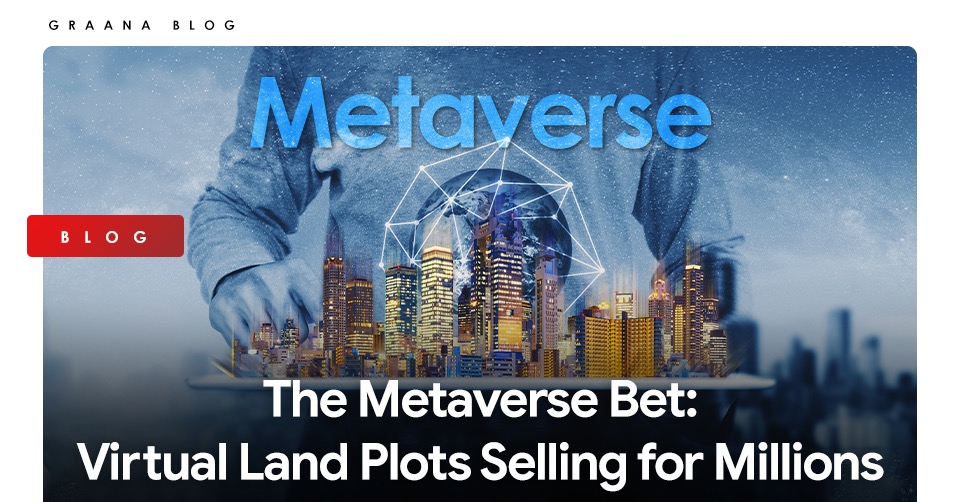Without an ounce of doubt, ‘Real Estate’ (RE) is booming in the ‘Metaverse’.
On Tuesday, a plot of digital land in Decentraland sold for $2.43 million worth of cryptocurrency.
For those wondering, Decentraland is an online, virtual-only environment, allowing users to explore, co-create, and interact with each other.
Digital land in virtual worlds is now selling for millions of dollars across different platforms, including Axie Infinity and Decentraland. Some prices are more than many physical properties in expensive cities. Explore these exciting concepts with the proptech pioneer Graana.com.

Real Estate in Metaverse: What do you need to know?
The concept of the Metaverse has just started to blow up. Many of the early companies that have invested in it are reaping many benefits of this emerging market trend.
The metaverse is a hyperbolic elucidation of virtual social reality, emerging as the hotspot for real-estate investments worth multi-million dollars in virtual land — even if the investors don’t see themselves living in these virtual spaces.
Global interest in the metaverse has spiked ever since Facebook changed its name to Meta. Enthusiasts buy plots in the metaverse as a speculative investment. Meanwhile, other digital properties have sold for huge price tags, too. Moreover, Crypto tokens linked to the metaverse have surged, with mana rising more than 60% in the past week.
A subsidiary of Tokens.com, Metaverse Group, completed the purchase of digital land for 618,000 mana, which is equivalent to about $2.43 million, according to a Decentraland spokesperson. Mana is Decentraland’s cryptocurrency that users employ to buy and sell in the virtual space.
The rise of the metaverse concept and the interest taken in it by companies is starting to affect the prices and sales of metaverse-related vital elements, like digital land and tokens. If we take this week as an example, there have been numerous sales of digital plots for millions of dollars in metaverse inspired projects. For those interested, the first sale of this kind was seen in February by Axie Infinity — a virtual world game — where a total of 8 plots of land were sold for $1.5 million or 888 ETH. When the sale happened, the buyer said it was a historic moment, the dawn of digital nations with their delineated, irrevocable property rights system.

Metaverse – the Digital Renaissance
Specifically, after Facebook’s rebranding as Meta, tech companies rush to claim a stake in the revolution. This revolution, of course, can simply be the primary step towards the digital renaissance or more immersive computing that many artists claim it to be. However, one obvious thing is that virtual worlds are getting exciting enough for million-dollar real-estate deals. Proptech investors are excited for the fusion of reality with augmented space. Virtual real estate has been seducing technopreneurs and investors since the NFT (non-fungible token) boom. Without deep rumination, it won’t be tough to draw a parallel between social media platforms and a metaverse like Decentraland. Platforms like these, in general, allow users to live in their carefully curated digital personas, having both — good and bad — outcomes.

Pros and Cons of Virtual Worlds
Talking about the good outcomes, users can express themselves through their digital egos — specifically with the properties they buy, have friends, and shop from the cosiness of their homes (real ones). This allows users to choose to visit any event or place, take control of the weather and select who can join. The metaverse enables a user to shut out unwanted people, consume good news and stay aloof from any bad news.
On the other hand, a metaverse could become an escape for users, like social media. The power to choose the persona could lead to people eventually feeling distant and depersonalised from their actual lives. AR (augmented reality) addiction could ultimately become as grave as smartphone addiction. Moreover, users might just buy digital assets in the metaverse because of the fear of missing out (FOMO). Meanwhile, those unable to purchase digital goods might feel disheartened, anxious, or even become depressed. As a result, the lines between real and virtual worlds will fade out, and users may find it more convenient to upgrade their avatars instead of constructing their real selves. In decades to come, Apple will entirely replace smartphones with AR. Whatever the outcomes might be, let’s leave some things for time to tell!
Conclusion
Whatever the case may be, the metaverse has the potential to generate $1 trillion annual revenue across the worlds of digital events, e-commerce, advertising, and hardware, as per a new report from crypto giant Grayscale. The report focuses on the immersive virtual world and says it is the internet’s future. Even though the report doesn’t specify the time frame, Grayscale noted that revenue from virtual gaming worlds could surge to $400 billion in 2025, from about $180 billion in 2020.
Yet Grayscale, a name that runs the world’s biggest cryptocurrency fund, maintained that the metaverse is “in its early innings.” However, Facebook’s intent to spend a whopping $10 billion on the metaverse this year is a sign of the market’s potential.
For news and blogs, visit Graana.com.





technology at its best